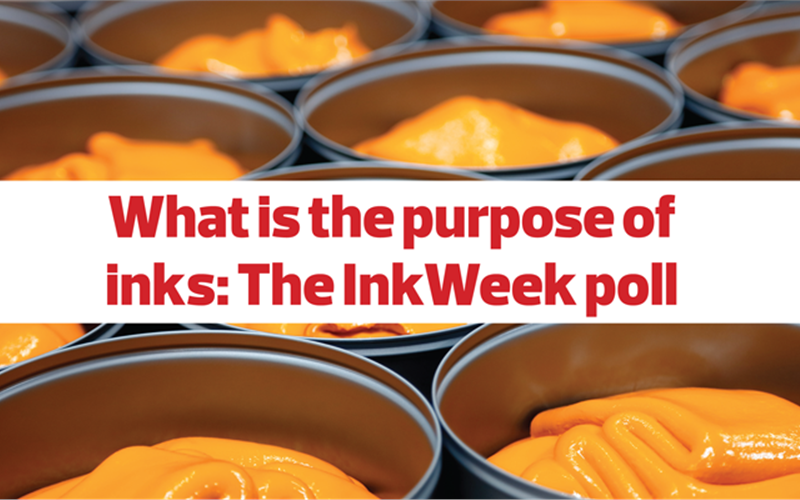What is the purpose of inks: The InkWeek poll - The Noel D'Cunha Sunday Column
The InkWeek poll says, ink makers who innovate quickly and plan better and adopt - are better placed and desired by the industry. Also, companies which do not invest in innovation and R&D are most likely to suffer and lose their market share.
Cost pressures remain high. The industry is concerned about who can better manage costs and maintain lesser disruptions in the supply chain. The focus for 2022 is sustainable.
Read all this in the Noel D'cunha Sunday Column
03 Apr 2022 | By PrintWeek Team
Most of the tech-talk we have been picking up on the ink groups is about technology. For example, faster setting inks. As more and more firms are experimenting with printing on filmic materials, users realise conventional offset inks tend to dry slowly; and so, they are asking their ink suppliers for drying accelerators etc. Also almost everyone has a query about spray powder anti-setoff. Then there is the conundrum about reduction in ink percentages if at all any scope without compromising the end result required of colour alacrity and values.
As the InkWeek poll suggests, anyone and everyone is interested in new ideas and latest innovations." During InkWeek, we heard of how a print firm in Gujarat worked with unique special application inks (a special ink for tamper-evident application). This ink is being deployed by Amazon. Apparently only two manufacturers in the world are doing this. Business owners want to learn more about how such an ink created an impact.
Today, many commercial print firms are seeking a solution in terms of what next? There is a good option in direct printing on garment and for transfer printing. We covered three DTG print firms who cater to brands like Nike, C&A, Tesco, H&M, M&S, Tomy, GAP, Walmart, Carry4 etc PLUS the Surat market. For print firms the system is quite straightforward. One has to get a GOTS and Oeko Tex certificate for this product. And promise to produce environmentally friendly and biodegradable sustainable products. Again, inks hold the key.
One theme that resonated in the InkWeek ink polls is: you have to be very strong in sourcing and inventory management. The entire supply chain – right from ink raw material supplier, to the ink manufacturer to the converters, to the brand owners to the packing centres. Everything has to work in tandem to succeed. Ink makers have scored a high 8/10 in this department in spite of all the challenges.





The InkWeek Poll throws up the following five trends
- During the past two years, the industry has been re-looking at packaging structures. This is perhaps a good time for everyone to look at substrates and material sciences
- To create a chain of training and ink mixing centres in all major towns of India where one can train people in the science of colour matching and ink mixing
- Cost is key. All the players are finding ways of reducing costs. Three things most good factories are talking about: efficiency of drying at high speeds, whether using solvents or even water. Also minimise the amount or number of solvents in the ink system, so that controlling viscosity will become easier. Use ink cooling systems where required to minimise solvent evaporation. Print and packaging firms are seeking tips and tricks
- One suggestion we received from a major label converter in Baddi during InkWeek was: Ink-makers can make features such as high light fastness, chemical resistance, scuff resistance, etc. standard features, rather than a separate grade of inks
- Can ink-makers in India look at agri components of the inks. If yes, what new chemistries and new R&D should we look at?
InkWeek poll conclusion
Run lengths will shrink and capacities to have multi-product portfolios with quick changes will be desired. Lower inventories will become the norm. All around cost will become the main focus. Customers will demand more service and solutions in a quick time. Many of the brands are saying automation is key. The pandemic has boosted technology-based growth. E-commerce packaging and remote and cloud-based solutions, such as remote diagnostic tools have become important.
Point is, there is a huge shift in society's habits and packaging has seen a boom in the past two years. Having said that, we must look at the increase in waste accumulation. Public policies exist. But we need greater awareness among the citizens about the consumption and disposal of post-used plastic.
The implementation of the single-use plastic ban policy along with a focus on recycling and biodegradability will bring about a major transformation in this sector. Currently, the Indian packaging industry consumes more polymers compared to the global average. This creates a unique opportunity for India to drive this industry towards sustainability, bio-based/paper-based packaging. Opportunity knocks. Are we ready?












 See All
See All